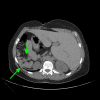Heterotaxy Polysplenia Syndrome in Adulthood: Focused Review and a Case Report
- PMID: 32181068
- PMCID: PMC7051111
- DOI: 10.7759/cureus.6822
Heterotaxy Polysplenia Syndrome in Adulthood: Focused Review and a Case Report
Abstract
Heterotaxy syndrome (Situs ambiguus) is a condition in which the internal organs are abnormally arranged in the chest and abdomen. Individuals with this condition have complex birth defects affecting the heart, lungs, liver, spleen, intestines, and other organs. Unlike situs inversus, it often causes serious health problems. This report describes a case of a 49-year-old Hispanic female with a significant medical history of situs ambiguous diagnosed at birth in Cuba. She has had little to no follow-up in adulthood due to being "healthy." She presented to the emergency room with intractable pain in the left lower quadrant and left flank for two days. Heterotaxy syndrome was found incidentally on CT scan of the abdomen/pelvis (plain). She was further evaluated with chest X-ray, magnetic resonance imaging of abdomen/pelvis without and with contrast, transvaginal ultrasonography, renal/bladder ultrasonography, left upper quadrant (LUQ) ultrasonography, esophagogastroduodenoscopy (EGD) with biopsy, 2D echocardiogram, and pertinent laboratory tests. Certain unusual findings included azygos continuation of the inferior vena cava (IVC), numerous spleens, atrophic pancreas, dilatation of duodenal C sweep, pelvic mass (possibly arising from right ovary), multiple nabothian cysts, and cardiac dysfunctions (such as severe mitral regurgitation). This report further aims to identify anatomic variants, previously established or otherwise not, in heterotaxy syndrome. Also, there seems to be a lack of identifiable anomalies or associations in regard to female anatomy, particular to this case being the female pelvic anatomy. As previous reports and research have stated, identification of anomalies in this syndrome is key for adequate and optimal management.
Keywords: heterotaxy syndrome; left isomerism; right isomerism; situs ambiguus; situs inversus.
Copyright © 2020, Lagrotta et al.
Conflict of interest statement
The authors have declared that no competing interests exist.
Figures







References
-
- Heterotaxy syndrome. [Sep;2019 ];Reference Reference, G. (2019. https://ghr.nlm.nih.gov/condition/heterotaxy-syndrome 2019
-
- Polysplenia syndrome detected in adulthood: report of eight cases and review of the literature. Gayer G, Apter S, Jonas T, et al. Abdom Imaging. 1999;24:178–184. - PubMed
-
- The syndrome of left isomerism. Berg C, Geipel A, Kamil D, et al. J Ultrasound Med. 2005;24:921–931. - PubMed
-
- Two rights make a wrong: human left-right malformations. Casey B. Hum Mol Genet. 1998;7:1565–1571. - PubMed
-
- Prenatal diagnosis of left isomerism with normal heart: a case report. De Paola N, Ermito S, Nahom A, et al. https://pubmed.ncbi.nlm.nih.gov/22439041-prenatal-diagnosis-of-left-isom... J Prenat Med. 2009;3:37–38. - PMC - PubMed
Publication types
LinkOut - more resources
Full Text Sources
Research Materials
